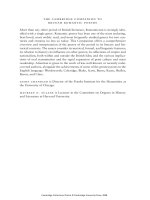The cambridge companion to british roman 59
Bạn đang xem bản rút gọn của tài liệu. Xem và tải ngay bản đầy đủ của tài liệu tại đây (38.64 KB, 1 trang )
Romantic poetry and antiquity
In the first decades of the nineteenth century there seemed to be a great
deal of history leading up to the present and following advances in a whole
range of new fields – from archaeology to comparative religion, from pottery
to vulcanology (the study of volcanoes). More history was being discovered
all the time. Writers, artists, historians, and critics became sensitized to the
inescapable presence of the past in everyday life – whether in the medieval
rights-of-way and boundaries of London, or in the enigmatic standing stones
and elusive oral folk traditions of the countryside. Moreover, history was
happening every day, persistently felt and lived through in explosive international events such as the French Revolution and the ensuing upheaval of
the Napoleonic Wars.
Antiquity in the general sense of “ancientness” therefore became integral
to many features of intellectual and cultural life in the period – in politics, poetry, interior design, and even the erotic (the principal definitions of
“antiquity” in Johnson’s Dictionary [1755–6] are “1. Old times; time past
long ago. 2. The people of old times; the ancients. 3. The works of remains
of old times”). Antiquity therefore covers classical Greece and Rome (and
Egypt), ancient Britain, and the medieval or Gothic. Considering the poetry
of antiquity in this way presents a challenge to the proposition that Romantic poets rebelled against the neoclassical straitjacket of eighteenth-century
Augustanism in a bid for the imaginative freedom of the Gothic – as if
taste evolved “from a reptilian classicism, all cold and dry reason, to a mammalian Romanticism, all warm and wet feeling.”8 Critics today are in danger
of replicating the split made at the time by commentators such as Hazlitt.
Rather, classical taste and Gothic taste were less in competition to become
the spirit of the age as complementary movements, both being literally rooted
in the past, and in the idea and uses of the past. If Scott’s comments in his
Minstrelsy of the Scottish Border (1803) suggest an opposition between the
Greeks and Romans on the one hand, and the Goths and Celts on the other,
and in the next year Joseph Cottle remarked that “whoever in these times
founds a machinery on the mythology of the Greeks, will do so at his peril,”
Byron had no qualms about combining, for example, Scotland with Homeric Greece in lines such as “And Loch-na-gar with Ida looked o’er Troy”
(“The Island,” Canto II, l. 291).9 Classical literature was certainly valued
differently at the end of the eighteenth century than at the beginning, but
still formed part of the story of Britain and provided valuable commentaries
on the activities of the so-called Goths and Celts.
“Gothic” has come to cover everything from the florid novels of Ann
Radcliffe to the architectural visions of Augustus Welby Pugin, and it is still
rapidly mutating today – as is clear from its ongoing popularity as an “alternative” fashion. Mid-eighteenth-century meanings of the term are, however,
37
Cambridge Collections Online © Cambridge University Press, 2008









